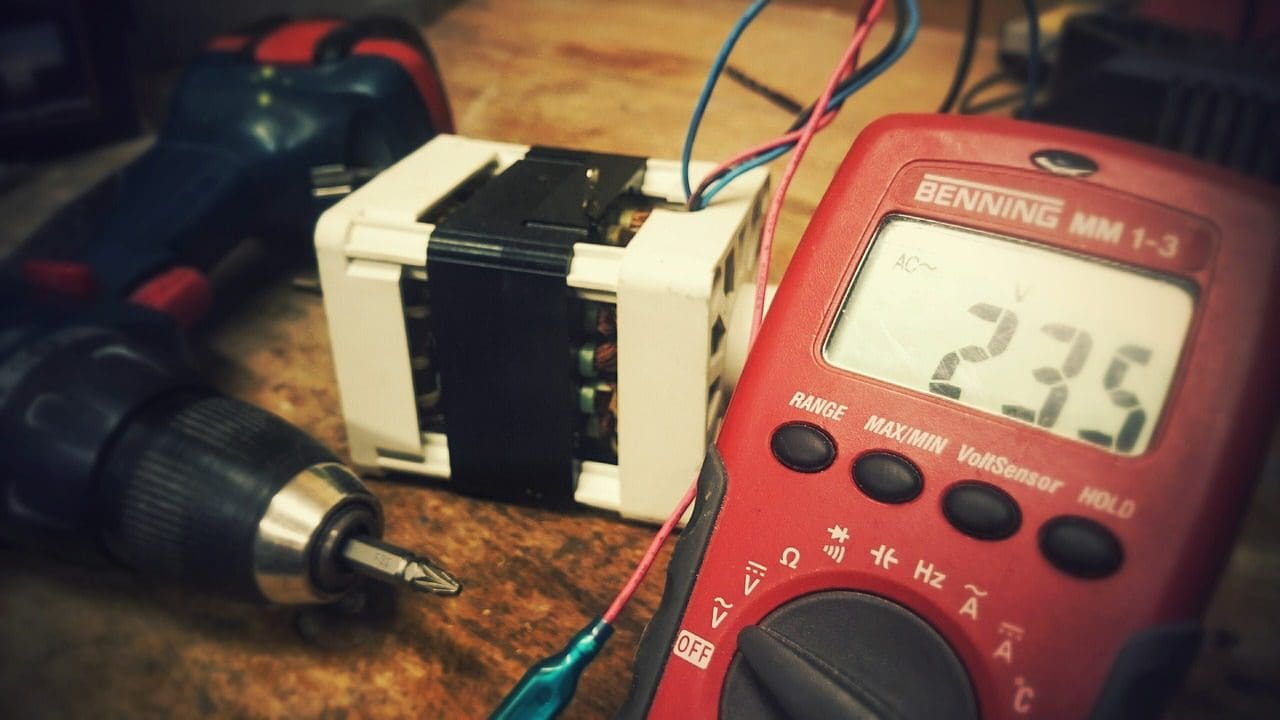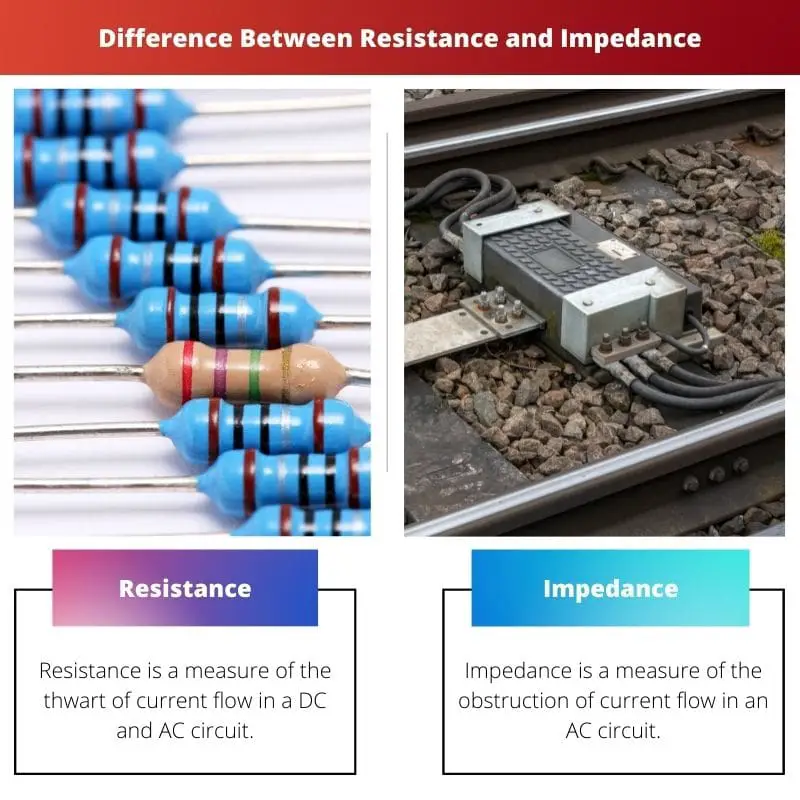A few concepts in physics would let us scratch our heads the most. Likewise, the difference between these two terms is one kind—meanwhile, both act as an obstruction in the flow of current or electricity.
Over and above, impedance and resistance are related, as impedance is the combination of resistance and reactance (inductance, capacitance).
Key Takeaways
- Resistance measures opposition to direct current (DC) flow, while impedance includes opposition to both DC and alternating current (AC) flow.
- Impedance is a complex quantity involving resistance and reactance, whereas resistance only considers the resistive component.
- In AC circuits, impedance plays a more significant role in determining current flow and voltage drops due to the presence of inductive and capacitive elements.
Resistance vs Impedance
The difference between resistance and impedance is that resistance is used in DC (Direct Current) circuits, while impedance is used in AC (Alternate Current) circuits. Besides, the resistance occurs due to resistivity elements. On the contrary, Impedance is due to factors like reactance and resistance.

Resistance is a famous term in the subject of Electricity Physics. It is the measure of the obstruction posed to the current flow in a DC circuit. The SI unit of resistance is Ohm, with the Greek symbol Omega.
It is introduced by Georg Ohm while determining Ohm’s Law, an equation relating voltage, current, and a constant (Resistance).
On the other hand, impedance combines resistance and reactance (Inductance and Capacitance). Similarly, it is also a measure of obstruction to the current flow in AC circuits.
It is denoted by the Symbol Z, and the SI unit is Ohms. The impedance is caused mostly by the magnetic and electric fields due to the collision of electrons inside the conductor.
Comparison Table
| Parameters of Comparison | Resistance | Impedance |
|---|---|---|
| Meaning | Resistance is a measure of the thwart of current flow in a DC and AC circuit. When electricity passes by generating ionic particles, resistance elements were created to hindrance the current flow. Resistance is denoted as R, and SI unit is Ohms. | Impedance is a measure of the obstruction of current flow in an AC circuit with the combination of reactance and resistance which, were created to impede the electricity. Impedance is denoted as Z, and the SI unit is Ohms. |
| Introduction | In the year 1827, german physicist Georg Simon Ohm invented resistance- a constant term, by understanding the relationship between current and voltage in a circuit. | Impedance was founded by an English Mathematician Oliver Heaviside in 1885. |
| Formula | Voltage= Current (Multiple) Resistance. | Impedance= √Resistance² (Add) Inductive Reactance (Minus) Capatative reactance. |
| Cause | Resistance occurs according to the material, length, area of cross-sectional of the conductor. | Impedance happens due to the resistance and reactance of the conductor. |
| Circuits | Resistance can be encountered in both DC and AC circuits. | Impedance can be done only in AC circuits. |
| Formation | Resistance can happen only by resistance elements and thwart the current flow with the help of material, length, area of cross-sectional of the conductor. | Impedance can happen only by the resistance and reactance of the conductor. |
What is Resistance?
The electrical resistance of an object is the measure of the obstruction to the current flow in a circuit. Moreover, resistance can be observed both in DC as well as AC circuits.
When electrons collide with the ionic particles of the conductor, the electrical energy is converted into heat, ultimately introducing an element to obstruct the flow of current through the conductor, and thereby the resistance arises.
It was invented by Georg Ohm while configuring Ohm’s Law, which determines the relationship between the current and voltage, and the constant term is resistance.
Over and above, the resistance of a circuit is affected by the length, cross-sectional area of the conductor, temperature, and resistivity material of the conductor. The SI unit of resistance is Ohms and is represented by the letter R.
The measure of the resistance is determined by dividing the voltage by that of the current in the circuit. The device used to measure resistance is called Ohmmeter.

What is Impedance?
The impedance concept was found by Oliver Heaviside in 1885. Impedance is the measure of the obstruction that impedes the flow of currency through a circuit. It arises in AC circuits, as it relates the sinusoidal voltages and current by a simple linear law.
It has both magnitude and phase, where magnitude is the ratio of voltage amplitude to current amplitude, and phase is defined as the phase shift by which current lags by the voltage.
Furthermore, impedance is the combination of resistance and reactance, while reactance is the combination of inductance and capacitance.
Moreover, resistance occurs due to the collision of charged particles with the internal surface of the conductor, while reactance arises due to the movement of the charged electrons.
It mostly forms in electromagnetic fields. The measure of impedance is determined by knowing the resistance, inductor reactance, and capacitor reactance.
The SI unit of impedance is also Ohms, the Greek word Omega. And it is represented by the letter Z.

Main Differences Between Resistance and Impedance
- Resistance is an obstruction of the current flow in both DC and AC circuits which is caused by resistance elements. On the other hand, Impedance is a measure of preventing current flow with resistance and reactance only in AC circuits.
- Resistance is denoted by the letter R, whereas Impedance is represented as Z. Both terms have the same SI unit as Ohms.
- Resistance is invented by german Physicist Georg Simon Ohm in 1827, while impedance was introduced by an English mathematician Oliver Heaviside in 1885.
- The resistance formula is Voltage= Current (Multiple) Resistance, but the Impedance formula differs as Impedance= √Resistance² (Add) Inductive Reactance (Minus) Capacitive reactance.
- Resistance is caused by the resistance elements, which are the material, length, and area of cross-sectional of the conductor. Albeit, Impedance happens only by resistance and reactance.

- https://aip.scitation.org/doi/abs/10.1063/1.1731798
- https://nyaspubs.onlinelibrary.wiley.com/doi/abs/10.1111/j.1749-6632.1999.tb09443.x

The article does a great job at explaining the difference between resistance and impedance with great detail, particularly in the Comparison Table.
I totally agree! The Comparison Table simplifies the complex concepts of resistance and impedance.
This article simplifies the differences between resistance and impedance in a well-structured manner.
The structure of the article makes it easier to grasp the complexities of resistance and impedance.
The article indeed presents the differences between resistance and impedance in a structured and understandable way.
The detailed comparisons between resistance and impedance offer valuable insights, making the article a highly educational read.
The article’s comparison table provides a clear and comprehensive view of resistance and impedance.
The article’s comparisons significantly contribute to understanding the complexities of resistance and impedance.
Informative article, and the distinctions between resistance and impedance are clearly articulated.
I found the distinctions made between resistance and impedance to be extremely clear and useful.
The clarity in differentiating resistance and impedance enhances the article’s quality.
Good read! The article has covered all the information in a concise manner and has explained the differences between resistance and impedance really well.
I agree, the article effectively distinguishes between resistance and impedance.
I found the comparison table to be really helpful in understanding the nuances of both resistance and impedance.
Very informative article, and the section discussing the introduction of resistance and impedance is well founded.
The historical background of resistance and impedance adds depth to the article’s content.
The historical context provided on the introduction of resistance and impedance is quite enlightening.
Insightful article that effectively explains the significance of resistance and impedance in electrical circuits.
The article does a great job at highlighting the relevance of resistance and impedance in electrical circuits.
The detailed explanation of resistance and impedance is commendable, overall, a well-researched article.
I appreciate the comprehensive explanation of resistance and impedance, makes understanding the concepts much easier.
The article brilliantly explains resistance and impedance in electrical circuits, making complex information very accessible and easy to understand.
The information on resistance and impedance is presented well, aiding in understanding these complex concepts.